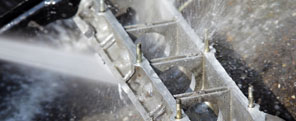 |
|||||||
Metal Part Cleaning Basics A clean metallic surface is required at various stages in metal parts production. A machined component, for example, must be cleaned before any subsequent surface finishing, such as coating or electroplating. Electroplating is particularly sensitive to surface contaminants, as they can prevent adhesion of the metal coating. Many terms have been applied to the cleaning of metal components, and nomenclature in this area can be ambiguous or misleading. Terms such as degreasing, metal surface cleaning, ultrasonic cleaning, parts washing, component cleaning, etc. are often used interchangeably. For our purposes, we are discussing the removal of any surface contaminants on metal components that are residual to the production processes that formed them, though implied with this is the removal of any particulates that have adhered to a part surface. The American Society for Testing and Materials (ASTM) defines six groups of contaminants: pigmented drawing compounds, unpigmented oil and grease, chips and cutting fluids, polishing and buffing compounds, rust and scale, and others. Chips and cutting fluids are the primary concern for machinists. For any given metal part, there are several approaches on how best to clean it. We restrict ourselves here to the cleaning of components through chemical, rather than mechanical means such as sand or shot blasting. There are five factors to be considered in determining a surface cleaning method or protocol: the impurities to be removed and the nature of the part(s), cleaning solution temperature, agitation, cycle time and concentration. The size and weight of the parts to be cleaned are both factors. Enormous parts may have to be cleaned individually by hand; smaller parts are usually cleaned in batches by immersion in a cleaning solution (often with the help of some vibration). The geometry of the parts is also important: complex, irregular geometries with threaded holes, etc. present the greatest challenges. 2. Use High Temperatures for Stubborn Soils Soils based on mineral oils, waxes or stearates can be tough to remove. Their high viscosities or water insolubility lead to cleaning resistance except at elevated temperatures -- in some cases approaching 200°F. The use of cleaning solutions at high temperatures helps break down the bonds that cause soils to adhere to metal. 3. Getting All Shook Up 4. Time Is of the Essence Generally speaking, more time soaking or under a spray means cleaner parts. However, demands on production volume have instead favored the development of faster-acting cleaners, more agitation and higher spray velocities for greater impingement. 5. Concentration Is Key Acculube's fluid specialists have decades of experience in metal cleaning techniques, and in choosing - and using - cleaning solutions that deliver the greatest benefits in cycle time, energy use, effectiveness and cost.
|

|
||||||
|
|||||||
|
|||||||
Accurate Lubricants & Metalworking Fluids, Inc.• 403 Homestead Avenue; Dayton, Ohio 45417 USA • Phone: 937-461-9906 Fax: 937-461-9917
|
|||||||
